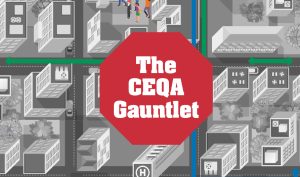Enviro law’s abusers continue to block urban housing
by John Seiler
There are many reasons for California’s housing crisis, but a major problem everyone acknowledges, but never comes close to resolving, is the inability to advance reform of the California Environmental Quality Act, or CEQA (pronounced See-Kwa). It thwarts the construction of new projects by giving anyone standing to tie the proposals up in court.
Well-intended when Gov. Ronald Reagan signed it into law in 1970 to help clean up the state’s polluted environment, CEQA has become an impediment to construction of all kinds. It now requires voluminous Environmental Impact Reports and other studies before construction begins. Hit hardest is housing in urban areas for the low-income residents the state’s leadership claims it wants to help. The law also gives any “stakeholder” grounds for filing a lawsuit that might stop or slow down any project.
“In the early days, initial studies and EIRs were generally quite short, and covered only truly public projects,” PRI fellow M. Nolan Gray, a professional city planner and a housing researcher at UCLA, wrote last year in the Atlantic. “But in 1972, the California courts interpreted a ‘public project’ to include any private development that required governmental approvals.”
He wrote of a proposed development in the Boyle Heights section of Los Angeles. Commuter bus and rail lines stretched an easy 30 minutes to downtown Los Angeles’ business district. “Yet when a local nonprofit developer proposed several years ago to build a 49-unit apartment building on the lot – with 24 homes set aside for disabled veterans experiencing homelessness – it was slammed with an environmental lawsuit.”

Called the Lorena Plaza, the nonprofit developer is A Community of Friends, which proposed the project nine years ago. Construction finally began this year. Another absurdity occurred to Habitat for Humanity, the housing-building charity associated with former President Jimmy Carter. In 2017, the highly respected group wanted to build 20 affordable homes in San Francisco. “Thanks to one cynical neighbor’s CEQA suit, Habitat faced delays and mounting environmental-review costs,” Nolan wrote. It only recently was completed.
The problem hits even wealthy areas, such as Newport Beach, Calif., where not everybody owns beachfront property. Like other cities, it is under state mandates to construct low-income housing. But an “environmentalist” sued to stop low-cost housing near John Wayne Airport.
The plaintiff “turned out to be another developer – Olen Properties Corp., a Newport Beach commercial property firm owned by billionaire real estate tycoon Igor Olenicoff,” reported the Orange County Register. “Apart from environmental issues, Olen worries the development would impact its office building by reducing street-level parking, disrupting tenants and creating more noise. The company argued further the Koll Center is giving away a portion of the parking lot, which it called a common area jointly held by all the center’s property owners.”
Another absurdity hit the University of California, Berkeley. An August 2021 ruling by Alameda County Superior Court Judge Brad Seligman sidelined the school’s expansion plans, potentially forcing it to cut fall 2022 enrollment by 3,050 students, while losing $57 million in lost tuition. He sided with plaintiff Save Berkeley’s Neighborhoods in demanding copious new environmental reviews of the plans.

In this case, the Legislature snapped into action and passed a CEQA exemption, greenlighting the expansion. (It also passed a law exempting similar projects from public universities.) It also has done so with other prestige projects, such as new stadiums for Los Angeles Rams, the Sacramento Kings, the San Francisco 49ers, the Golden State Warriors and the Los Angeles Clippers. Billionaire owners and millionaire players gain the ears of legislators. Run-of-the-mill projects, even for poor people, seldom can get such privileged treatment.
CEQA’s main problem is legal obstacles too easily can hamstring new developments for years. Gov. Gavin Newsom did sign into law three reform bills in September 2021. One was Senate Bill 10, by state Sen. Scott Weiner, D-San Francisco. It allowed increased density by permitting more “up-zoning” through simpler CEQA requirements. Well and good. But what’s needed is more comprehensive reforms that get at the heart of the obstructions used by labor unions, environmental groups and even competing construction companies.
“The lack of CEQA reform is choking low-income housing,” Lucy Dunn told me; she’s the president emeritus of the Orange County Business Council. “It’s the new Jim Crow,” meaning it’s preventing minorities from getting ahead because they can’t get decent housing at a reasonable price. Given the ongoing concern about covert “redlining” – keeping minorities out of some neighborhoods, another legacy of Jim Crow – why isn’t CEQA a prime target for reform?
There really is a civil rights crisis. CalMatters reported on an “urban exodus” in which 250,000 Black Californians “have left high-cost coastal cities in the last three decades … Black renters have been disproportionately forced out of cities as costs and evictions climbed; the Black population has plunged 45 percent in Compton, 43 percent in San Francisco and 40 percent in Oakland.”
A big part of the overall problem is California is the only state in which environmental laws can be filed anonymously. It sounds like a posse of invisible villains from the Marvel Universe. But it’s real.

A 2018 study for the Hastings Environmental Law Journal by environmental lawyer Jennifer Hernandez found “newly minted, unincorporated groups with environmental sounding names filed nearly half to the most CEQA lawsuits … anonymously. Additionally, lawsuits can be filed by parties attempting to advance an economic rather than environmental agenda, such as business competitors, labor unions and ‘bounty hunter’ lawyers seeking quick cash settlements, even if they have no real client.”
The fate of serious attempts at reform is shown by Senate Bill 1248 from 2016, by state Sen. John Moorlach, R-Costa Mesa. (Full disclosure: I was a Moorlach staffer, 2017-20.) It would have required all parties who file CEQA litigation under the pseudonyms of unincorporated associations to reveal their identities. Moorlach was defeated for re-election in 2020 because of public-employee union opposition to this and other reform proposals. Unions use CEQA to hold up projects that don’t use higher-priced union labor.
“We tried SB 1248 and the Dems killed it in the first committee, with two Republicans supporting, five Democrats against,” Moorlach said. “So one Republican tried to reform CEQA.” One Democrat who might have advanced comprehensive reform was Gov. Jerry Brown during his second stint in the governor’s chair, 2011-19. “Jerry Brown touched enough third rails, such as pension reform, but decided to leave CEQA alone even though he hated it,” Moorlach said.
“Probably the best course is to do a ballot measure in 2024,” Moorlach added. That would give reformers two years to work on comprehensive reform planks including SB 1248’s end of anonymous lawsuits and exempting from CEQA requirements what’s called “infill development,” which is in areas where sewers, public transportation and other urban infrastructure already exists.
In California, real reform almost always comes from initiatives put before voters. It looks like that’s the only way CEQA can be reformed to ease the state’s worsening housing crisis – especially in its biggest cities. Unless a Marvel superhero comes in to save the day.
John Seiler writes on California for the Orange County Register. Write to him at [email protected].

